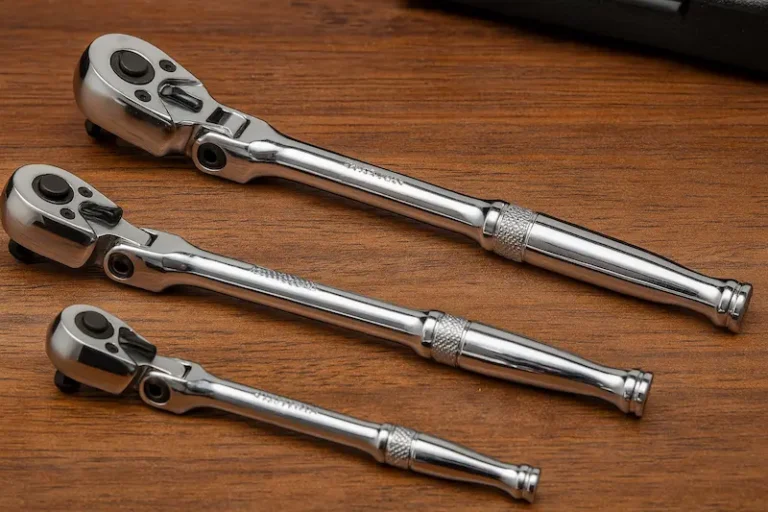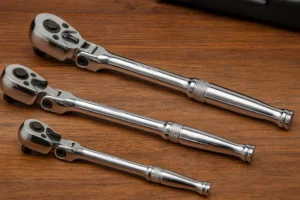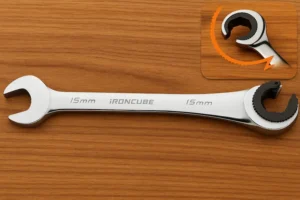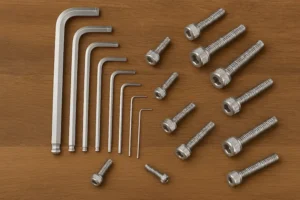A socket wrench is a manual tool that uses removable sockets to grip fasteners, applying torque to tighten or loosen nuts and bolts. The core advantage of a socket spanner lies in combining a ratchet handle with interchangeable sockets, enabling the tool to grip fasteners of different sizes without requiring multiple separate wrenches. Unlike open-end wrenches or box wrenches, which require repositioning after each turn, the socket wrench uses a ratchet mechanism that allows continuous rotation in one direction while locking in the opposite direction, enabling efficient and uninterrupted operation—especially in tight spaces.
The socket spanner operates based on its ratchet mechanism, typically composed of a gear and pawl system within the handle. When you turn the handle in the tightening direction, the pawl engages with the gear, transmitting torque to the socket and fastener. When turning in the opposite direction, the pawl disengages, allowing the handle to reset without moving the fastener. This mechanism significantly improves efficiency by eliminating the need to lift and reposition the tool during repetitive turning tasks, making socket wrenches indispensable in automotive, mechanical, and construction fields.
Check here to get the Socket Ratchet Wrench set from Ironcube
Socket Wrench Definition
The socket spanner operates based on its ratchet mechanism, typically composed of a gear and pawl system within the handle. When you turn the handle in the tightening direction, the pawl engages with the gear, transmitting torque to the socket and fastener. When turning in the opposite direction, the pawl disengages, allowing the handle to reset without moving the fastener. This mechanism significantly improves efficiency by eliminating the need to lift and reposition the tool during repetitive turning tasks, making socket wrenches indispensable in automotive, mechanical, and construction fields.
Key identifying features of a socket wrench:
- The square drive at the handle end of the socket wrench (not a fixed wrench opening)
- Directional switch or lever near the socket spanner drive head
- Removable slot that fits into the square drive
- Ratchet action of the socket wrench allowing one-way rotation
The socket spanner (British terminology) refers to the same tool, emphasizing the socket component that “spans” or grips the fastener. Both terms describe identical tools with identical functions.
Practical identification
If you can remove the end piece (socket) from the handle and the handle makes clicking sounds when turned, you’re holding a socket wrench. The removable socket distinguishes it from all other wrench types.
What components make up a socket wrench?
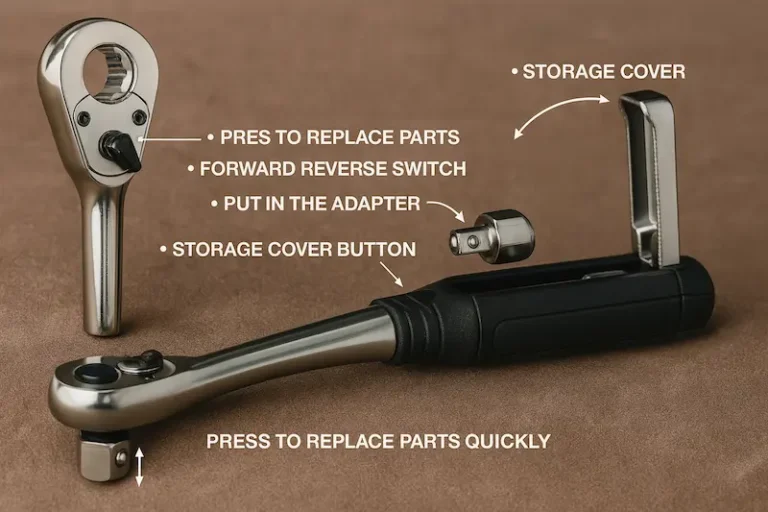
The socket wrench consists of five main modules: ratchet handle (or drive handle), ratchet mechanism, drive square (drive stud), socket (interchangeable), quick-release button (optional on some models). These components work together to effectively deliver torque and allow for quick tightening or loosening of bolts and nuts. Below, I will detail their functions:
Ratchet Handle
- The ratchet handle of a socket wrench contains gears and a ratchet mechanism
- Features a directional switch (typically a small lever)
- Standard length: 8–12 inches, suitable for most applications (custom lengths available upon request)
- Grip area: Typically textured rubber or plastic for comfort
Drive Square
- A metal square (or ball detent) protrusion typically located at the end of the handle.
Standard sizes: 1/4“ (6.35mm), 3/8” (9.525mm), 1/2“ (12.7mm), 3/4” (19.05mm) - The Drive Square typically includes a spring-loaded ball or pin to secure the socket.
- It determines the system’s maximum torque capacity.
Ratchet Mechanism
- The ratchet mechanism typically consists of a pawl, switch, directional switch, and gear, located at the front end of the socket wrench.
- The Directional Switch on the Ratchet Mechanism has three positions: clockwise, counterclockwise, and locked to control the direction of ratchet engagement, typically marked with an arrow or R/L indicator
- Pawl – A spring-loaded rod that engages with the gear teeth.
Sockets
- Sockets are cylindrical tool components mounted on the socket wrench.
- Standard wall thickness: varies by application (thin walls for confined spaces)
- Socket interior: 6-point or 12-point openings for gripping fasteners
- The dimensions we typically refer to are the metric and SAE sizes, depth (shallow/deep), and style (6-point, 12-point) offered by sockets
Quick-Release Button (Optional, on some models)
- The Quick-Release Button is typically a spring-loaded ball within the drive housing.
- It is the component that keeps the socket attached during use.
How Does a Socket Wrench Work?
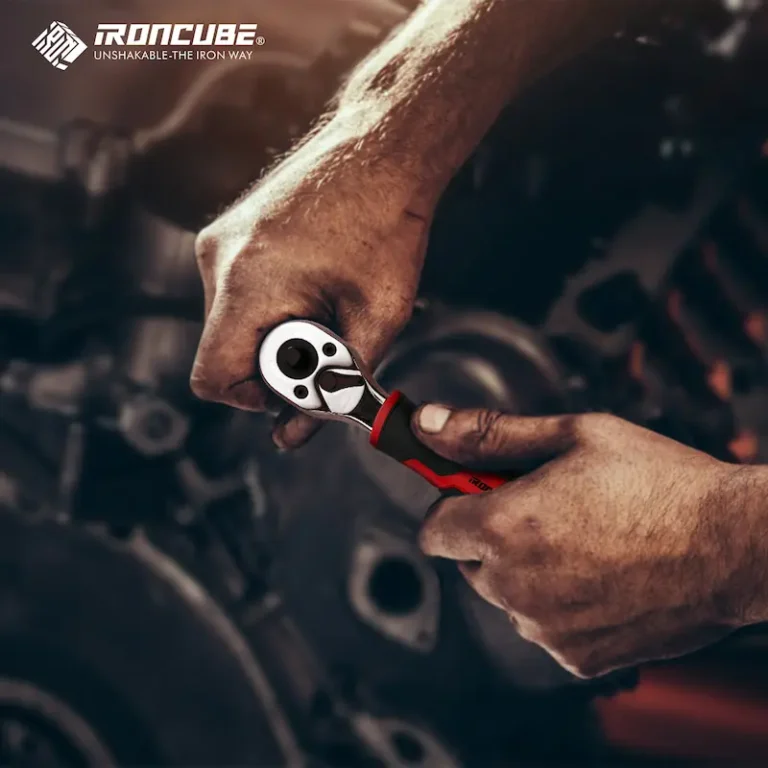
The socket wrench operates by transferring rotational force (torque) from the user’s hand to the fastener (e.g., nut or bolt) via a removable socket that fits snugly over the fastener head. The key to its efficiency is the ratchet mechanism built into the handle, which allows continuous tightening or loosening without the need to remove and reposition the tool after each rotation.
The socket wrench achieves efficient tightening/loosening through torque transmission + ratchet one-way engagement. The handle acts as a lever arm, where the force F applied by the user multiplied by the handle length L produces torque T = F × L. This torque is fully transmitted through the drive square to the socket, which then fully wraps around the hexagonal face of the nut at 360°, distributing the torque evenly along the threaded axis. This reduces the risk of stripping or edge damage caused by off-center force application. Compared to open-end wrenches with two contact points and box wrenches with six contact points, the socket’s twelve-point or six-point full-enveloping contact design provides higher allowable torque under the same force and avoids concentrated stress on the fastener.
Below is a breakdown of the working steps of a socket wrench
Step 1: Pawl Engagement When you turn the handle clockwise (for tightening), a small metal piece called the pawl drops into the gear teeth inside the handle. This creates a solid connection between your hand motion and the socket, transferring your turning force directly to the fastener.
Step 2: Return Stroke When you turn the handle counterclockwise (return motion), the pawl slides over the gear teeth with clicking sounds. The fastener doesn’t move during this return stroke—only the handle moves, resetting your grip position.
Step 3: Continuous Operation You can repeat this clockwise-counterclockwise motion continuously without lifting the socket off the fastener. Each forward stroke tightens the fastener; each return stroke repositions your hand.
Socket Attachment Process
- Push the slot onto the drive square until you hear/feel a click
- The spring ball inside the drive square pops into the socket’s hole
- The ball secures the socket in place during use
- Removal: Pull the socket directly out (the ball compresses and releases)
Practical Example
When removing a car’s lug nut, first select a socket that matches the lug nut’s size, then set the socket wrench’s ratchet to counterclockwise, place the socket on the lug nut, and perform short, back-and-forth motions. Each leftward movement slightly loosens the nut; each rightward movement only resets your hand position without re-tightening the nut.
what is the difference between a socket wrench and other wrenches?
The primary difference between socket wrenches and other types of wrenches lies in how they grip fasteners and how effectively they apply torque—especially in narrow or repetitive work spaces. Below is a comparison with several common types of wrenches.
Read more about: How to Use a Ratchet Wrench: Complete Step-by-Step Guide
Socket Wrench vs Ratcheting Wrench
While both tools incorporate ratcheting mechanisms, the fundamental difference lies in fastener size versatility. Traditional ratcheting wrenches feature fixed openings that accommodate single fastener sizes, requiring separate tools for different dimensions. Socket wrench systems use interchangeable sockets that enable a single handle to work with multiple fastener sizes, dramatically reducing tool inventory requirements.
The socket approach also provides superior fastener access in confined spaces, as the socket’s cylindrical design offers greater clearance around fastener heads compared to the larger profile of fixed wrench heads. However, ratcheting wrenches often provide thinner profiles for extremely tight spaces where socket clearance becomes limiting.
Read more about the Socket Wrench Vs Ratcheting Wrench
Socket Wrench vs Open-End and Box Wrench
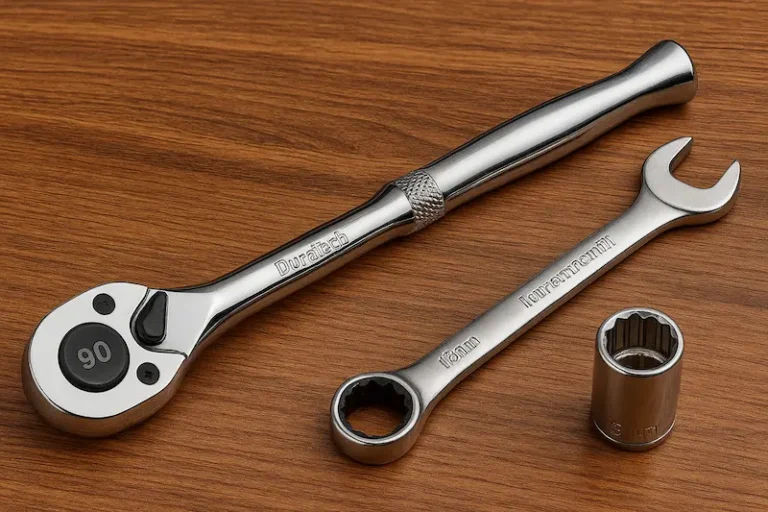
Traditional open-end wrenches contact fasteners at only two points, creating stress concentrations that can damage both tool and fastener under high loads. Box wrenches provide full fastener engagement but require complete access for installation. Socket wrenches combine the full engagement benefits of box wrenches with the accessibility advantages of modular design.
The socket system also eliminates the need for double-ended wrenches with different sizes, as socket changes provide infinite size flexibility within the drive system’s capacity range. This modularity proves particularly valuable in applications requiring frequent size changes or when working with mixed fastener standards.
how many types of socket wrenches?
Here, I am only providing a general overview of socket wrench types. I will dedicate a separate article to detailing the specific types of socket wrenches.
Drive Size Classifications: Socket wrench systems organize around standardized drive sizes that determine capacity, torque limits, and socket availability. The 1/4-inch drive system targets light-duty applications such as electronics work, small appliance repair, and precision assembly where delicate torque control matters more than raw power.
The 3/8-inch drive represents the most versatile category, handling general automotive work, household maintenance, and light industrial applications. This size offers optimal balance between tool size, torque capacity, and socket selection, making it ideal for DIY enthusiasts and professional mechanics working on passenger vehicles.
Half-inch drive systems provide the backbone of professional automotive and industrial maintenance, offering substantial torque capacity while maintaining reasonable tool size. The 3/4-inch and larger drives serve heavy industrial applications, commercial vehicle maintenance, and construction equipment service where maximum torque delivery justifies larger tool dimensions.
Read more about How Does a Ratchet Wrench Work? Complete Explained
Handle Design Variations: Socket wrench handles vary significantly in design philosophy and intended applications. Traditional ratcheting handles provide reliable operation with comfortable grip designs, typically featuring 72-tooth mechanisms that require 5-degree swing angles for operation in confined spaces.
Breaker bars offer extended length for maximum torque multiplication but sacrifice ratcheting convenience for ultimate mechanical advantage. T-handle designs provide excellent torque control for precision applications, while speed handles enable rapid fastener rotation in situations where ratcheting action proves unnecessary.
Professional Specializations: Specific industries drive socket wrench specialization that addresses unique operational requirements. Automotive socket sets emphasize sizes common in vehicle service, often including both metric and SAE dimensions with specialized sockets for spark plugs, oxygen sensors, and other automotive-specific fasteners.
Industrial socket systems may incorporate impact-rated construction for pneumatic tool compatibility, while electronics applications demand precision construction and anti-static properties. Marine and aerospace applications require corrosion-resistant materials and specialized certifications that ensure reliability in demanding environments.
Best Ratcheting Brake Line Wrench for 2025: Professional Buying Guide & Reviews
What are the advantages and disadvantages of a socket wrench?
Understanding socket wrench benefits and constraints enables informed tool selection while maximizing system advantages in appropriate applications.
Operational Efficiency Advantages
Socket wrench systems deliver substantial efficiency gains through reduced tool changes, continuous ratcheting operation, and optimized fastener engagement. The ability to maintain consistent grip and handle position while changing socket sizes minimizes setup time and reduces operator fatigue during extended work sessions.
The ratcheting mechanism enables operation in confined spaces where traditional wrenches would require constant repositioning, often reducing task completion time by 50-70% compared to fixed wrench alternatives. This efficiency advantage compounds in applications involving numerous fasteners or repetitive assembly operations.
Versatility and Inventory Benefits
A single socket wrench handle paired with appropriate socket sets can replace dozens of individual wrenches, dramatically reducing tool inventory requirements and storage space. This consolidation proves particularly valuable for mobile technicians, DIY enthusiasts with limited workspace, or professional shops managing tool costs.
The modular nature of socket systems enables expansion as needs evolve, allowing users to add specialized sockets, extensions, or alternative handles without replacing entire tool sets. This adaptability makes socket systems excellent long-term investments that grow with user capabilities and requirements.
Precision and Control Benefits
Quality socket wrench systems provide superior fastener engagement compared to open-end alternatives, with 6-point and 12-point socket geometries that distribute loads across fastener faces rather than corners. This design philosophy minimizes fastener damage while enabling higher torque application when necessary.
The consistent handle positioning afforded by socket systems improves operator control and reduces the likelihood of slipped tools that can damage fasteners, surrounding components, or operator hands. The positive engagement characteristic of quality sockets also provides tactile feedback that helps operators gauge appropriate torque levels.
Disadvantages of socket wrenches
Expensive:Compared to basic fixed wrenches, socket wrenches are more expensive, especially when you want a complete set of socket spanners. This is because they have many components, and the price of these components is higher than that of ordinary components.
Higher failure rate: Compared to fixed wrenches, socket wrenches have additional potential points of failure. The drive mechanism, locking system, and ratchet assembly are all potential sources of failure. While high-quality tools can minimize these risks, the increased complexity itself reduces overall durability compared to simpler fixed tools.
Access and Space Constraints: Despite their versatility, socket systems face limitations in extremely confined spaces where the socket length and handle clearance exceed available working room. Ultra-thin profile situations may require specialized low-profile sockets or alternative tool approaches entirely.
How to Choose the Right Socket spanner for Your Needs?
Selecting the appropriate socket wrench system requires careful consideration of intended applications, quality requirements, and long-term tool development plans. Let’s delve into the details:
Application Assessment: Before purchasing a socket wrench, analyze the primary use cases and fastener types you frequently encounter, and avoid being swayed by marketing claims. For example, automotive enthusiasts typically benefit from a 3/8-inch drive system with comprehensive metric and SAE socket coverage, while electronics work requires 1/4-inch precision tools with specialized drill bits and adapters. Heavy-duty applications such as truck maintenance, construction equipment servicing, or industrial machinery repair demonstrate that 1/2-inch or larger drive systems provide robust torque capacity. Mixed-use scenarios typically benefit from multiple drive sizes, which optimize tool selection for specific tasks while minimizing overlap and redundancy.
Quality and investment considerations: The quality of socket spanners varies significantly across different price ranges. Professional-grade tools justify their higher cost through superior materials, precision manufacturing, and extended service life. When assessing quality levels, consider usage frequency, working conditions, and performance requirements. It is not recommended for everyone to purchase expensive professional-grade socket spanners, as ordinary socket spanners are sufficient for most users.
DIY users may find mid-range tools offer excellent performance for occasional use without the premium associated with ultimate professional features.
System Compatibility and Scalability: Choose socket wrench systems from manufacturers that offer comprehensive accessory series and long-term product support. Standardized drive systems ensure compatibility across different manufacturers, but proprietary features may limit future expansion options.
Consider starting with a basic kit covering essential sizes and applications, then expanding with specialized sockets, extensions, and accessories as specific needs evolve. This approach spreads investment over time while ensuring tools remain suitable for changing requirements.
Conclusion
Understanding what is a socket wrench reveals far more than simple tool identification—it opens appreciation for sophisticated engineering solutions that revolutionized mechanical work efficiency and capability. The socket wrench system represents the evolution from single-purpose tools to modular systems that adapt to diverse requirements while maintaining professional-grade performance standards.
The socket wrench stands as testament to human ingenuity in tool design, proving that elegant solutions often emerge from systematic analysis of operational challenges combined with creative engineering implementation. Master socket wrench concepts, and you master fundamental principles that support mechanical competence across countless applications and continuing technological evolution.
The Complete Guide to Types of Ratcheting Wrenches: Everything You Need to Know in 2025
